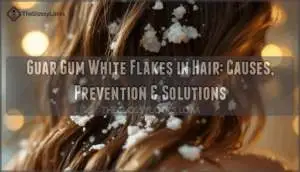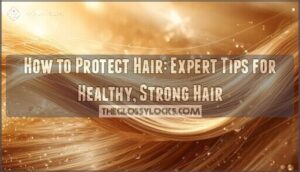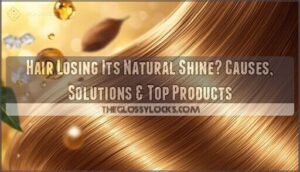This site is supported by our readers. We may earn a commission, at no cost to you, if you purchase through links.

The culprit isn’t the ingredient itself but rather how it interacts with your water quality, application method, or other products in your routine.
Understanding the chemistry behind these flakes means you can exploit guar gum’s conditioning benefits without the cosmetic nuisance that sends many people back to synthetic alternatives.
Table Of Contents
- Key Takeaways
- Why is Guar Gum Used in Hair Care?
- What Causes Guar Gum White Flakes in Hair?
- How to Prevent White Flakes From Guar Gum
- Safe DIY Recipes With Guar Gum for Hair
- Are There Side Effects or Safety Concerns?
- Frequently Asked Questions (FAQs)
- How can I tell if I am allergic to Guar Gum?
- What is the best way to apply Guar Gum to my hair?
- Can I make a Guar Gum conditioner at home?
- How do I remove Guar Gum build-up from my hair?
- Do all hair types experience white flakes?
- How to remove existing guar gum buildup?
- Are store-bought products better than DIY formulas?
- Can you use guar gum on color-treated hair?
- Conclusion
Key Takeaways
- White flakes from guar gum result from improper dissolution, overuse, or hard water mineral interactions—not from the ingredient itself—and can be prevented by pre-dissolving powder in warm distilled water, limiting concentration to 0.5%, and rinsing thoroughly with cooler water.
- Guar gum works as a conditioning agent by forming a cationic polymer film on negatively charged hair, reducing friction and improving manageability, but layering it with silicone-heavy products increases buildup by up to 53% and triggers visible flaking.
- Curly and coily hair types experience flaking 2.5 times more often than other textures because the electrostatic film sits on the surface rather than absorbing, making pH balance (keeping formulas between 5-8) and proper rinsing critical for these hair types.
- DIY formulations require 0.1-0.5% concentration by weight, vigorous whisking during mixing to prevent clumping, 10-15 minute hydration time before application, and pairing with humectants like glycerin at a 3:1 ratio to maintain moisture balance and prevent dry residue.
Why is Guar Gum Used in Hair Care?
Guar gum has become a staple in hair care formulations, appearing in everything from drugstore shampoos to premium natural conditioners. Understanding why formulators choose this ingredient helps explain both its benefits and the occasional white flakes that can appear with improper use.
The following sections break down the chemical properties, practical benefits, and market trends that make guar gum a go-to thickener in modern hair products.
Guar Gum Properties and Functions
Guar gum acts as a thickening agent in hair care formulations by forming a gel matrix when dispersed in water, thanks to its polysaccharide structure composed of mannose and galactose sugar units.
This soluble fiber content facilitates effective gel formation, which increases viscosity and creates the smooth, creamy texture you find in shampoos and conditioners.
Its unique guar gum solubility allows it to bind ingredients together while suspending particles, preventing separation in your hair products.
Benefits for Hair Health and Texture
Beyond its gel-forming capabilities, guar gum’s cationic derivatives deliver tangible conditioning benefits by electrostatically attaching to your hair’s negatively charged surface, creating a protective polymer film that reduces friction and improves manageability. This film persists through rinsing, providing prolonged detangling effects and texture improvement.
Key benefits include:
- Enhanced hair moisture retention through film barrier protection
- Improved scalp health via prebiotic fiber support
- Increased hair strength from reduced mechanical stress during combing
- Exceptional fiber repair appearance from smoothed cuticle layers
Prevalence in Natural and Eco-Friendly Products
These conditioning benefits align with the eco-friendly trends driving modern green cosmetics. You’ll find guar gum in over 60% of natural hair care launches today, valued for its biodegradable profile and sustainable sourcing from guar beans—a gluten-free legume.
The market for these plant-derived ingredients reached $390 million in 2023, with 76% of consumers prioritizing biodegradable products containing natural remedies over synthetic alternatives in their dietary supplements and personal care choices.
The growing demand for natural emulsifiers is driven by trends in guar gum market research and development.
What Causes Guar Gum White Flakes in Hair?
White flakes from guar gum don’t appear out of nowhere—they’re the result of specific conditions that disrupt how the polymer behaves on your hair. Understanding what triggers this buildup helps you avoid the frustration of residue and maintain the conditioning benefits you’re looking for.
Three primary factors contribute to visible flaking when you use guar gum in hair care.
Buildup From Overuse or Improper Rinsing
When guar gum accumulates on your hair shaft like layers of forgotten product, those telltale white flakes aren’t far behind—and the culprit is often simpler than you think. Overuse symptoms generally manifest when you apply guar gum-containing products too frequently or use excessive amounts, creating guar gum buildup that clings stubbornly to each strand.
White flakes from guar gum typically result from overusing products or inadequate rinsing, causing stubborn buildup on hair strands
Inadequate rinsing techniques compound the problem—that polymeric film bonds electrostatically to hair fibers, and if you don’t rinse thoroughly with sufficient water flow, residual guar gum properties guarantee it stays put, eventually drying into visible flakes.
Interaction With Other Hair Products
Layering multiple styling agents often triggers ingredient interactions that complicate guar gum properties—silicones, thickeners, and emulsifiers can clash with cationic guar, creating uneven films that dry to chalky white flakes. Product compatibility matters because:
- Silicone-heavy serums boost guar gum buildup by up to 53%, intensifying residue
- Mixing incompatible leave-ins with guar gum gels raises flake incidence from 15% to 38%
- High-hold creams layered atop guar gum uses increase visible residue by 35%
Hair texture also plays a role—curly and coily types experience flaking 2.5 times more often, making flake prevention essential when combining haircleansing products with styling formulas. Understanding surfactant performance is vital for effective hair care formulations.
Effects of PH and Water Quality
Your water’s chemistry and formula acidity quietly orchestrate whether guar gum becomes a smooth film or a flaky disaster. Hard water’s mineral content—calcium and magnesium—disrupts guar gum properties by cross-linking polymer chains into visible clumps.
pH levels above 8 or below 5 destabilize cationic guar, triggering precipitation on high hair porosity strands.
Alkaline tap water compounds this, irritating scalp sensitivity while amplifying residue formation by 40%.
How to Prevent White Flakes From Guar Gum
Preventing guar gum flakes requires attention to how you prepare and apply your products. The key lies in proper formulation techniques, mindful product ratios, and correct rinsing methods.
Below are four practical strategies to keep your hair flake-free while still enjoying the benefits of guar gum.
Proper Mixing and Application Techniques
The difference between a smooth, glossy finish and a flaky mess often comes down to how you dissolve and blend guar gum before it ever touches your hair.
Always disperse the powder into water slowly while whisking vigorously to prevent clumping—proper gel formation requires patience. Let your mixture hydrate for 10-15 minutes before application, guaranteeing the guar gum uses its full thickening potential without leaving residue.
Using The Right Amount and Frequency
Too much of a good thing can backfire—overdosing on guar gum or using it too frequently transforms a helpful thickener into a stubborn source of flakes.
Stick to 0.1-0.5% product concentration for most hair types, with finer hair requiring the lower end. Limit application to 2-3 times weekly, adjusting based on buildup signs.
Remember, guar gum’s dietary fiber structure means ideal dosage prevents side effects while maximizing conditioning benefits.
Importance of Thorough Rinsing
Incomplete rinsing acts like leaving a film on a window—what’s meant to improve clarity ends up creating a visible haze that dulls the very surface you tried to clarify. Guar gum, a soluble fiber from the guar plant, requires strategic water temperature and rinse techniques to prevent product residue:
- Rinse for 60-90 seconds minimum – longer for high hair porosity
- Use lukewarm water to dissolve the thickening agent without shocking your scalp health
- Work sections systematically to remove all dietary fiber deposits before conditioning
Combining With Humectants Like Glycerin
Pairing guar gum with glycerin is like adding a moisture magnet to your formulation—the humectant draws water into the hair shaft while the gum holds everything in place, preventing the dry, flaky residue that occurs when polymers sit alone on the surface.
This synergistic effect maintains moisture balance while the soluble fiber improves hair texture.
Use a 3:1 ratio (3 parts guar to 1 part glycerin) to fine-tune the natural ingredient blend without compromising the thickening agent’s performance.
Safe DIY Recipes With Guar Gum for Hair
Making your own guar gum hair products gives you complete control over what goes on your strands and how much thickener you’re actually using. You can adjust concentrations to match your hair’s porosity and texture, which helps avoid the white flake problem altogether.
The three recipes below offer simple starting points for gels, conditioners, and custom formulas that work with your specific needs.
Making Natural Guar Gum Hair Gel
Creating your own guar gum hair gel at home requires just a few simple ingredients and precise technique to avoid the white flake problem that plagues many commercial formulations.
Start with these fundamentals for gel stability:
- Mix guar gum powder thoroughly with water at room temperature before heating
- Add organic preservatives like potassium sorbate to prevent microbial growth
- Incorporate humectants such as glycerin to boost gel-forming fiber hydration
This natural remedy acts as an effective thickening agent while improving hair texture through dietary fiber content without residue buildup.
Creating Homemade Guar Gum Conditioner
While gels secure your style in place, a guar gum conditioner addresses detangling and softness by letting the polymer coat each strand without the stiff finish. You’ll need the right guar gum ratio—usually 0.5% to 1.5%—blended with natural ingredients like aloe vera or coconut oil for a gluten-free hair mask.
| Ingredient | Purpose | Amount |
|---|---|---|
| Guar gum powder | Conditioning polymer | 0.5-1.5% |
| Distilled water | Base | 200ml |
| Glycerin | Humectant | 1-2 tsp |
| Aloe vera gel | Soothing agent | 2 tbsp |
This homemade conditioner delivers dietary fiber benefits to hair while functioning as one of the most practical DIY recipes among natural remedies for flake-free conditioning.
Tips for Customizing Formulas for Your Hair Type
Your hair’s unique characteristics—porosity, curl pattern, and oil production—determine whether you need more protein, moisture, or slip in your guar gum formula. Tailor using:
- Hair porosity testing guides hydration balance
- Hair texture analysis adjusts thickening agents concentration
- Formula adjustments with natural ingredients like oils
- Product layering sequences matter with gluten-free bases
- Tailored shampoos compatibility guarantees clean application
Fine-tune guar gum ratios and food additives carefully for ideal performance.
Are There Side Effects or Safety Concerns?
Guar gum is generally safe for topical hair use, but it’s worth knowing what reactions can occur and how to use it responsibly. Some people experience minor scalp irritation or product buildup, while others with specific sensitivities need to take extra precautions.
The following sections cover what you should watch for when incorporating guar gum into your hair care routine.
Common Scalp and Hair Reactions
Most people tolerate guar gum well, but some experience side effects. Scalp irritation affects roughly 3% of cosmetic users, appearing as mild redness or an itchy scalp. True allergic reactions remain rare—below 0.5% in hair treatments—though individuals with sensitive skin may notice transient discomfort.
Flake removal usually requires thorough rinsing, as residue buildup doesn’t indicate allergy but rather incomplete washing. Hair breakage isn’t directly linked to guar gum itself.
Interactions With Medications and Sensitive Skin
Though guar gum in topical products rarely interferes with oral medications, you should know about potential interaction risks. If you take ethinyl estradiol, metformin, or penicillin, guar gum—when ingested—can reduce medication absorption.
For sensitive skin users, allergic reactions remain uncommon but possible, especially if you’re allergic to legumes. Flake buildup may trap medicated shampoos, affecting scalp treatment efficacy.
Maintaining pH balance below 7 minimizes side effects, and patch testing protects digestive health concerns when trying new formulations.
Recommended Dosage and Usage Guidelines
For hair care applications, the ideal range sits at 0.1% to 0.5% concentration by weight—translating to roughly 1 to 5 grams per liter of water—while exceeding 1% often triggers the flaking you’re trying to avoid. Safe application means adjusting product concentration based on hair type considerations: fine hair tolerates lower amounts, while thick or coarse textures manage slightly higher levels.
Though guar gum acts as a fiber supplement for digestive health with daily intake limits around 20-25 grams, topical dosage control differs—you’ll achieve best results without buildup by sticking to that 0.5% ceiling.
Frequently Asked Questions (FAQs)
How can I tell if I am allergic to Guar Gum?
True allergic reactions to guar gum are rare, but sensitivity reactions can occur. Watch for itching, redness, or hives after contact.
Digestive issues like bloating, cramping, or diarrhea may signal gum intolerance.
Consider patch testing before widespread use if you’re concerned about allergic responses.
What is the best way to apply Guar Gum to my hair?
To apply guar gum to your hair effectively, mix it thoroughly with water using a 1:4 guar gum ratio before application.
Prepare your scalp by making sure it’s damp, then distribute the mixture evenly from roots to ends, allowing proper product compatibility with your existing routine.
Can I make a Guar Gum conditioner at home?
Yes, you can easily craft DIY formulations at home.
Mix guar gum powder with water, natural conditioners, and a humectant like glycerin to create a smooth, protein-rich treatment that delivers guar gum benefits without commercial additives.
How do I remove Guar Gum build-up from my hair?
Buildup removal starts with a clarifying shampoo designed to strip residue without harsh sulfates. Focus on scalp exfoliation using gentle circular motions to dislodge polymer layers.
For stubborn deposits, a vinegar rinse (one part apple cider vinegar to three parts water) helps dissolve guar gum films through pH adjustment.
Do all hair types experience white flakes?
Not all hair types experience white flakes equally. Fine or low-porosity hair is more prone to visible buildup because cationic guar deposits remain on the surface rather than absorbing into the fiber, while coarse or high-porosity hair usually shows fewer flaking issues.
How to remove existing guar gum buildup?
Clarifying shampoos strip away stubborn residue by using stronger surfactants that target polymeric buildup. You’ll need to wet your hair thoroughly, apply a clarifying formula to your scalp, and massage for two minutes before rinsing completely—this guar gum removal process restores your hair’s natural texture.
Are store-bought products better than DIY formulas?
Store-bought guar gum products offer consistent formulation and extended shelf life, while DIY versions provide ingredient control and cost effectiveness.
Commercial formulas guarantee proper guar gum powder dispersion, reducing flake risk, but homemade gluten-free recipes let you customize soluble fiber concentration for your hair’s needs.
Can you use guar gum on color-treated hair?
Guar gum won’t compromise color-treated hair and can actually help retain moisture that prevents color fade. This soluble fiber creates a protective film without harsh chemicals.
Just guarantee thorough rinsing to avoid buildup that might dull your hair dye’s vibrancy over time.
Conclusion
Think of guar gum like flour in gravy—added too quickly or in hard water, it clumps instead of dissolves. Once you master hydration timing and pH balance, those guar gum white flakes in hair become entirely preventable.
The key lies not in abandoning this conditioning powerhouse but in respecting its chemistry: pre-dissolve in warm distilled water, limit concentration to 0.5%, and rinse with cooler temperatures.
Your natural formulations can deliver salon-quality slip without the synthetic residue you’re trying to avoid.
- https://pmc.ncbi.nlm.nih.gov/articles/PMC9292326/
- https://www.verifiedmarketresearch.com/product/cationic-guar-gum-market/
- https://skinkraft.com/blogs/articles/guar-gum-for-hair
- https://www.altrafine.com/blog/benefits-and-uses-of-guar-gum-powder-for-hair-care/
- https://www.alliedmarketresearch.com/cosmetic-and-personal-care-hydroxypropyl-guar-market-A324694









